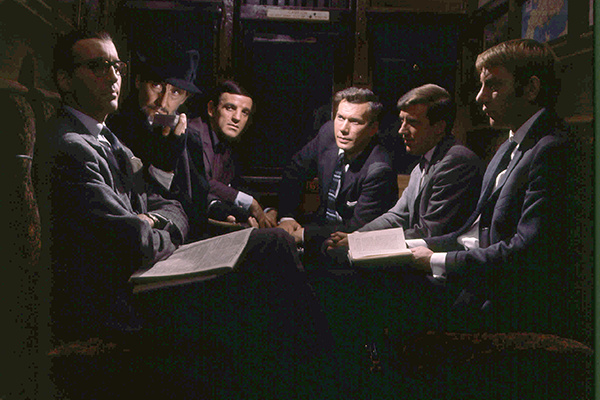To the sounds of the somewhat pretentious "Night on Bald Mountain", Dr. Miller arrives at the mental hospital, intent on getting a position there.
Thus begins "Asylum" (1972), one of the later Amicus Omnibus movies, sporting four tales of terror. It is directed by Roy Ward Baker, who had his hands in other horror films of the time, like "Scars of Dracula" and "Quatermass and the Pit." Some of the supporting players have similar credentials. Robert Powell, who plays Dr. Miller, starred in "The Asphyx" (also from 1972), a personal favorite of mine. He also played Captain Walker in "Tommy". Patrick Magee, who plays the wheelchair-bound Dr. Rutherford, had roles in "The Skull", "The Masque of the Red Death" and "A Clockwork Orange." Herbert Lom, who portrayed "The Phantom of the Opera" in 1962, is an inmate. And, of course, no Omnibus film would be complete without an appearance by Peter Cushing!
Dr. Miller has been challenged. It seems that the head of the hospital, Dr. Starr, has gone over the edge. He put Dr. Henderson in that wheelchair and has assumed a new personality. If Dr. Miller wants the job, he must figure out which of four patients he will meet is Dr. Starr. Each story tells of twisted minds that see and do things that scream insanity...or do they?
No discussion of this film can leave out its writer, Robert Bloch. He wrote Psycho, which is loosely based on the life and crimes of Ed Gein. So, what do they do? They give him a whole insane asylum to play with. And he seems to relish the opportunity.

In the first story,"Frozen Fear", we can see that Bloch has learned his lessons from his friend and mentor, H.P. Lovecraft. In the story, "Herbert West, Re-animator", Lovecraft writes about West's experiments that bring limbs back to life. Arms and legs are seen moving about under their own power. In this segment, Walter (Richard Todd), the unfaithful husband and his mistress, Bonnie (Barbara Parkins of "Valley of the Dolls" fame) are menaced by the arms and legs of his dismembered and beautifully wrapped in butcher paper (how apropos) wife, Ruth (Sylvia Syms, who would go on to play the Queen Mother in "The Queen"). Here, Bloch was allowed to show a taste of the gruesome ideas that went into Lovecraft's "Re-animator" that were not included when the story was finally filmed in 1985.
The next weird tale is "The Weird Tailor". Bruno, a tailor, played by stage and screen actor Barry Morse, and his wife are facing eviction when an odd gentlemen, played by Peter Cushing, enters the store and asks the tailor to make a suit for his son. He brings the material, the measurements and a series of instructions as to when exactly work on the suit. He offers the tailor more money than he has seen in weeks. He takes the job. When completed, Bruno finds that the man is looking to resurrect his son, who had passed away "too early". Of course, the tailor is appalled. A fight over the suit begins and Cushing is killed. Bruno runs back to the shop with the suit and places it on his tailor's mannequin, which magically comes to life, menacing the tailor and his wife. Re-animation once again rears its horrific head.
"Lucy Comes to Stay" is the story of a friend and the how much help she can be. Barbara, an unbalanced wife seems to find a sense of balance when her friend Lucy is around. The acting here is wonderful, as Charlotte Rampling plays Barbara and Britt Ekland plays Lucy. Both are top flight actresses. Lucy knows what will help Barbara. She needs to escape! So, by stabbing Barbara's husband and axing Barbara's nurse, the two are free to run off and live the life they choose. The police find only Barbara's fingerprints on the scissors and the ax. There is no sign of Lucy. Bloch refers back to the concept of split personalities that served him well in Psycho.

The penultimate story is "Mannikins of Horror." Herbert Lom portrays a doctor who believes that by sheer concentration, he can bring little robot-like creatures of himself to life. Of course, no one believes him. This lack of belief is key in many of Lovecraft's stories, as characters did not believe the evidence of their own eyes until it is too late. This concept was also used by Bloch. In "Yours Truly, Jack the Ripper," no one believed a researcher that Jack is still alive. By killing people in a varied mystical patterns, he maintains his life. In the end, someone did believe. Once again, only too late do people believe.
Herbert Lom seems more adept at playing someone who is insane. He would be driven into a padded cell by Inspector Clouseau in "The Pink Panther" series. Even in a comedy like "The Ladykillers", his character boarders on the homicidal.
Does Dr. Miller figure out who Dr. Starr is? Does he even survive to take on the job? The film ends as it began, to the strains of "Night on Bald Mountain".

Although not the strongest of Amicus' Omnibus films, it does deliver its share of shudders. The use of disembodied limbs and small 'Mannikins' with real working internal organs are excellent effects for horror tales. They are the best stories of the four. Having Robert Bloch's stories to draw from is a definite plus, as he had a well-know talent for creating horrors few would imagine. Performances by Rampling, Ekland, and Cushing help to buoy the other stories.
In all, I think "Asylum" is somewhat of the "poor relation" of Amicus. That same year, the studio released "Tale from the Crypt", based on the EC comics of the 1950s. It received much more attention in the press and likely is where Amicus put most of its efforts. In spite of this, "Asylum" is still a better film than many that were released in the early 1970s.
"Despite my ghoulish reputation, I really have
the heart of a small boy.
I keep it in a jar on my desk."
Robert Bloch
If you haven't seen this film, it is available on YouTube. Enjoy!!









